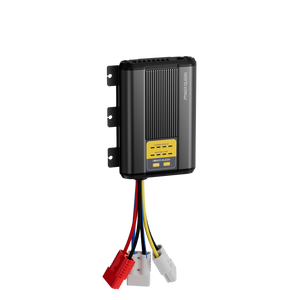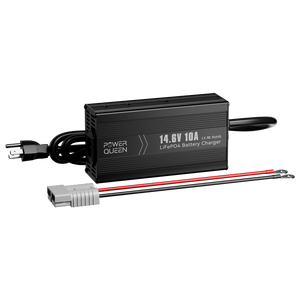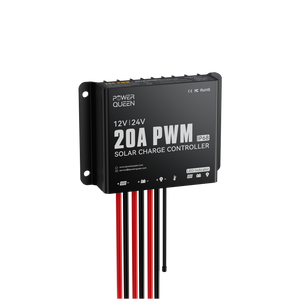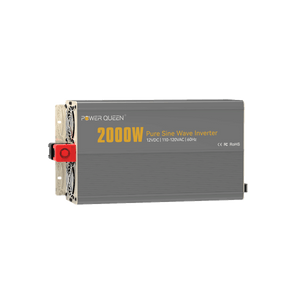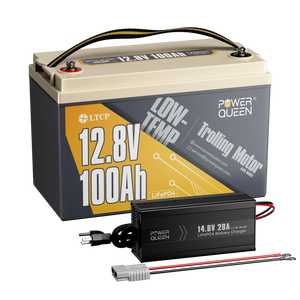Charging Two Batteries In Parallel
A practical way to guarantee a consistent and dependable power source for a range of applications, including off-grid solar systems and marine and recreational vehicle installations, is to charge two batteries in parallel. Batteries can last longer and operate more efficiently if they are charged in parallel.
This article will show you how to charge two batteries in parallel, going over the methods, safety measures, and advice you need to make sure the process is both safe and efficient.
Table of Content
- Part 1. What Does Charging Batteries in Parallel Mean?
- Part 2. Benefits of Charging Batteries in Parallel
- Part 3. Step-by-Step Guide to Charging Batteries in Parallel
- Part 4. Differences Between Batteries in Parallel vs. Series
- Part 5. Precautions to Know Before Wiring Batteries in Series or Parallel
- Part 6. Why Choose Power Queen Lithium Batteries
Part 1. What Does Charging Batteries in Parallel Mean?
The positive and negative terminals of batteries are connected to one another when they are connected in parallel configuration. This configuration boosts the total capacity (amp-hours) while maintaining the same voltage as a single battery. For instance, two 100Ah 12V batteries connected in parallel will still provide 12V but have a 200Ah total capacity.

Part 2. Benefits of Charging Batteries in Parallel
- Increased Capacity: Keeps the voltage constant while increasing the overall amp-hour capacity.
- Extended Battery Life: By balancing the load, proper parallel charging might result in extended battery life.
- Redundancy: Ensures a steady power source by acting as a backup in the event that one battery fails.
Part 3. Step-by-Step Guide to Charging Batteries in Parallel
Connecting several batteries to a single charger at once is known as parallel charging. Although this approach might be useful and efficient, it needs to be used carefully to guarantee safe and efficient charging. This is a comprehensive guide to parallel battery charging:
3.1 Prepare the Batteries:
Make sure both batteries fulfill the following requirements before beginning:
- Similar Capacities: To avoid problems with uneven charging, choose batteries with comparable capacity.
- State of Charge: To prevent imbalances, both batteries should ideally be in a comparable state of charge.
- Battery Type: To guarantee compatibility during charging, use batteries of the same kind (such as lead-acid batteries).
3.2 Connecting the Batteries:
Positive Terminal Connection: Connect the first battery's positive terminal to the second battery's positive terminal using a high-quality cable.
Negative Terminal Connection: Likewise, attach the first battery's negative terminal to the second battery's negative terminal using an additional cable.
Secure Connections: Make sure that every connection is snug and secure to avoid sparks or inefficient charging.
3.3 Attach the Charger:
Positive Lead: Attach one of the batteries' positive terminals to the charger's positive lead.
Negative Lead: Attach the charger's negative lead to the other battery's negative terminal.
Charger Capacity: Verify that the capacity of the charger equals or surpasses the total capacity of the batteries being charged.
Please refer to the table below for details on the voltage requirements of different LiFePO4 battery systems and packs. Select the appropriate charger by visiting Power Queen Lithium Battery Chargers.

3.4 Begin the Charging Process:
Check Connections: Double-check all connections to verify they are secure and appropriately insulated.
Turn on the Charger: After all connections have been confirmed, turn on the charger to begin charging.
3.5 Monitoring and Maintenance:
Monitor Charging: If this is your first time charging these batteries in parallel, pay great attention to the charging procedure.
Voltage Checks: Make sure each battery is charging uniformly and within safe bounds by routinely checking its voltage using a multimeter.
Inspect Terminals and Cables: Check battery cables and terminals for corrosion or other problems that can impair performance on a regular basis.
3.6 Safety Tips:
Protective Gear: Wear safety glasses and gloves at all times to protect yourself from dangerous sparks and battery acid.
Ventilation: Particularly while working with lead-acid batteries, charge them in a space with enough ventilation.
Supervision: Never leave the charging process unsupervised, particularly when utilizing new equipment or during early setups.
You can securely and successfully charge multiple batteries in parallel by adhering to these procedures and safety precautions, which will guarantee your battery setup's longevity and best performance.
Part 4. Differences Between Batteries in Parallel vs. Series
Depending upon your particular requirements, you can link batteries in series or parallel. Every configuration has unique properties that affect the battery system's voltage, capacity, and overall performance. A thorough comparison of parallel and series batteries can be found here:
4.1 Voltage and Capacity
4.1.1 Parallel Configuration:
- Voltage: The total voltage of a battery connected in parallel stays the same as the voltage of a single battery. For example, if two 12V batteries are connected in parallel, the voltage stays at 12V.
- Capacity: The aggregate of the capacities of the individual batteries is the overall capacity, which is expressed in ampere-hours, or Ah. You can get 200Ah from two 12V batteries, each having a 100Ah capacity.
4.1.2 Series Configuration:
- Voltage: The sum of the voltages of each battery in a series connection is the total voltage. For instance, two 12V batteries connected in series produce a voltage of 24V overall.
- Capacity: One of the individual batteries' capacities is still equal to the entire capacity. 100Ah can still be produced by two 12V batteries, each with a 100Ah capacity.
4.2 Application Suitability
4.2.1 Parallel Configuration:
- Use Case: Perfect for uses when more capacity at the same voltage is needed. Applications requiring longer usage duration, such solar power systems and recreational vehicles, frequently employ this arrangement.
- Benefits: Lengthens the interval between charges by increasing total capacity.
4.2.2 Series Configuration:
- Use Case: Ideal for uses when a higher voltage is required. This is frequently seen in power tools, electric cars, and other gadgets that need to produce more power.
- Benefits: Raises the overall voltage, enabling the operation of equipment and motors with greater power.
4.3 Charging and Discharging
4.3.1 Parallel Configuration:
- Charging: Batteries must be charged uniformly when connected in parallel to avoid imbalances. Using a charger that can manage the combined capacity is crucial.
- Discharging: As long as they are the same kind and age, batteries discharge uniformly when connected in parallel, guaranteeing a steady source of power.
4.3.2 Series Configuration:
- Charging: A charger that is equal to the series connection's total voltage should be used to charge batteries connected in series. To avoid overcharging or undercharging, it is essential to keep an eye on each battery.
- Discharging: A weak battery can have an impact on overall performance because all batteries in series deplete at the same rate when discharging.
4.4 Redundancy and Reliability
4.4.1 Parallel Configuration:
- Redundancy: Improves redundancy since the remaining batteries can still supply power in the event of a battery failure, albeit at a lower capacity.
- Reliability: Because it can better withstand battery failures, it is more dependable in applications where a steady power supply is essential.
4.4.2 Series Configuration:
- Redundancy: Less redundancy since the system as a whole could malfunction if one battery dies.
- Reliability: Less dependable in terms of redundancy, yet required for higher voltage applications.
4.5 Wiring Complexity
4.5.1 Parallel Configuration:
- Wiring: Connects all of the positive and negative connections together, however it's simple and requires additional wiring.
- Considerations: To prevent imbalances or short circuits, care must be taken to guarantee that all connections are secure.
4.5.2 Series Configuration:
- Wiring: Because you connect the positive terminal of one battery to the negative terminal of the next, it's easier and requires fewer connections.
- Considerations: To prevent problems, make sure each battery is balanced and operating properly.
Part 5. Precautions to Know Before Wiring Batteries in Series or Parallel
To guarantee safety and effectiveness, it is essential to take specific precautions when wiring batteries in parallel or series. Here is a detailed list of safety measures to take:
5.1 General Precautions for Both Configurations:
5.1.1 Matching Batteries:
To avoid imbalances that can cause overcharging or undercharging, use batteries that are the same age, kind, and capacity.
- Identical batteries with the same BMS (A) and battery capacity (Ah);
- Since each kind of lithium battery has a unique BMS, the batteries are all from the same brand.
- Purchased quickly (within a month)
Before connecting the batteries, make sure they are all in a comparable level of charge.
5.1.2 Inspect Batteries:
Before joining, look for any obvious corrosion, leaks, or damage. To maintain good contact, make sure the terminals are clean and corrosion-free.
5.1.3 Quality of Connectors and Cables:
Make use of cables and connectors of superior quality that are capable of supporting the anticipated current load.
To avoid sparks or poor conductivity, make sure all connections are snug and secure.
5.1.4 Personal Safety:
Always wear protective clothing, such as gloves and safety glasses, to guard against electrical sparks and battery acid.
To prevent breathing in any gases that batteries, particularly lead-acid ones, may produce, work in an area with adequate ventilation.
5.1.5 Tools:
In order to avoid unintentional short circuits, use insulated tools.
To verify correct connections and check voltages, keep a multimeter handy.
5.2 Precautions for Series Configuration:
5.2.1 Voltage Compatibility:
Make sure the combined battery voltage does not above the charger's or device's voltage rating.
The higher voltage should be avoided as it might be more hazardous and result in more severe electric shocks.
5.2.2 Charging:
Make use of a charger that is equal to the series connection's total voltage.
Regularly check the voltage of each battery to make sure it is charged evenly and to avoid overcharging or undercharging.
5.2.3 Weak Battery Impact:
Be advised that the performance of the entire arrangement may be impacted by a single weak or broken battery in the series, which could result in decreased efficiency or failure.
5.2.4 Balanced Charging:
To guarantee that all batteries charge and discharge uniformly, think about utilizing a battery balancer or equalizer.
5.3 Precautions for Parallel Configuration:
5.3.1 Current Handling:
Verify that the extra current load brought on by parallel connections can be supported by the cables and connectors.
Overly thin cables should not be used since they can overheat and start a fire.
5.3.2 Even Charging and Discharging:
To avoid significant current flows between batteries, which can lead to heating and damage, make sure the batteries are at comparable charge levels before connecting them.
To make sure all batteries are charging equally, keep a constant eye on the charging procedure.
5.3.3 Failure Redundancy:
Individual batteries should be checked frequently to make sure they are not failing because a dead battery will make the other batteries work harder, which could result in failures.
5.4 Specific Safety Tips:
5.4.1 Avoid Short Circuits:
To make sure there are no short circuits, double-check every connection.
Jewelry and metal tools might unintentionally produce short circuits, so use particular caution when handling them.
5.4.2 Proper Ventilation:
Batteries should be charged and stored in an area with enough ventilation to prevent the dangerous accumulation of gasses.
5.4.3 Fire Safety:
In case of an emergency, keep a fire extinguisher that is rated for electrical fires close by.
Batteries should never be charged close to combustible objects.
5.4.4 Regular Maintenance:
To guarantee long-term dependability and safety, periodically check and maintain the battery terminals and connections.
Use a solution of baking soda and water to remove any corrosion from the terminals, then rinse with water and pat dry completely.
5.4.5 Battery Specifications:
Always wire, charge, and maintain your batteries according to the manufacturer's instructions.
You may guarantee a secure and efficient battery wiring configuration, whether in series or parallel, to consistently and effectively supply your power requirements by taking these precautions.
Part 6. Why Choose Power Queen Lithium Batteries
Power Queen offers high-tech, reasonably priced lithium deep cycle batteries for off-grid, golf cart, marine, and RV applications.
- EV-grade cells UL, FCC, CE, ROSH, and UN38.3 certified with over 4,000 life cycles
- Low-temperature cut-off prevention; integrated BMS to safeguard batteries against overcharge, overdischarge, overcurrent, overheat, and short circuits
- Offer clients timely online services around-the-clock, skilled technical support, a generous return policy, and well understood operation manuals.























